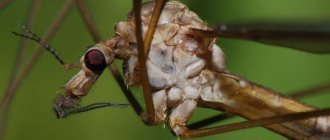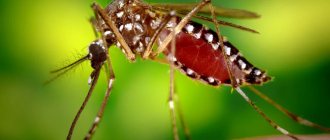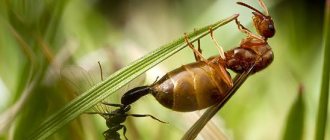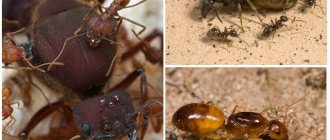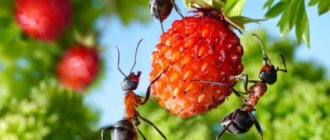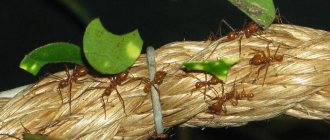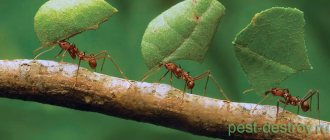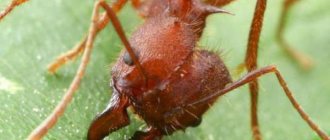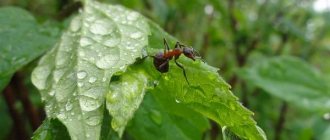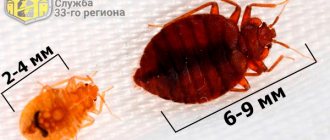Ants are one of the most common insects in nature. They can be found in almost any country, any climate and weather conditions. The only places where they have not yet been recorded are Greenland and Antarctica, as well as some isolated islands in the world's oceans. Ants are social creatures; they cannot exist alone. These insects have their own hierarchy of society, in which each individual occupies a certain place and performs the tasks assigned to it by nature. There is a queen ant whose main task is to perform reproductive functions. Other ants are divided into workers and males. The role of the former is to take care of the anthill family, and the latter is to continue the family line.
In this article we will look at the issue of ant life expectancy. Many people are interested in such information solely from a general educational point of view, and some people who have encountered ants at home or in an apartment want to know how long they will have to endure this scourge.
What do ants look like?
The body of an ant (in Latin - Formicidae) consists of three sections: head, chest and abdomen.
All parts of the body are connected to each other by elastic bridges, which makes the ants very flexible, mobile and resourceful. There are three pairs of limbs on the chest. The head is usually large and equipped with powerful mandibles, necessary for grinding food, holding food, or generally for defense. The life cycle of an ant includes the following stages: egg, larva, pupa and adult. It is at the larval stage that the diet of the larva determines who will be born: the queen, infertile females, males, or just worker ants. This entire process takes from 1 to 2 months.
Myrmica rubra: red myrmica
Insects of this subspecies are also called ruby ants due to their specific coloring and original chitinous cover. Ants are widespread in the European part, as well as in the Urals and Siberia.
Females of the red myrmica grow up to 6 mm at maturity and have a distinct reddish tint. Males are slightly darker and shorter – up to 5 mm. Anthills are located in the ground: under old logs, stumps and stones.
Myrmics are predators and, in pursuit of prey, paralyze it with poison. For humans, contact with ruby ant acid is quite painful and is accompanied by severe pain and redness of the skin. In the process of life, insects crush wood, thereby creating favorable conditions for the mineralization of cellulose-degrading bacteria.
Red myrmica
How many years does an ant live?
The life span of ants depends on what species and what caste it belongs to. From birth, the caste of the insect is determined and it does not change throughout its life. Worker ants, queens and males live in one family.
However, not all species of these insects exhibit a strict division into castes. Individuals of black garden and pharaoh ants can change their “specialization” throughout their lives. A newborn ant can take care of larvae and eggs, later - set up a home, and at the end of life - get food.
In addition, the length of an insect's life cycle is affected by its size. It has been noticed that the larger the ant, the more likely it is to live a longer life. The conditions of its life also play a significant role in determining how long an ant will live.
"Brief Life" or Longevity
There is no single answer to the question of the life expectancy of ants. If we consider all the information reliably known to entomologists about how long ants live in nature, then the minimum indicator is five days, and the maximum reaches twenty-eight years - a kind of record by ant standards.
Such an important indicator as the length of the life cycle is directly related to two parameters of the insect:
- its variety;
- belonging to a caste.
The lifespan of an ant depends on its species and the caste to which it belongs.
Some species of these insects, especially those that live in the northern part of the globe, are capable of hibernating during the winter. At this time, all processes in the individual’s body practically stop. And after the insect awakens, the functions of the organs are completely restored, and the ant returns to normal life with renewed vigor.
Ants live the longest in northern regions, as they hibernate for most of the year.
Taking into account the fact that ants living in such frosty regions as Kamchatka and Kolyma hibernate for most of the year - almost nine months, we can conclude that northern individuals live much longer than those who live in warm regions and do not fall into hibernation But this is only in total, that is, activity plus a period of inactivity. If we consider only active periods (from hibernation to hibernation) as life expectancy, the result will be noticeably less.
Representatives of the same species live longer at low temperatures than at warm temperatures. This is also supported by the fact that the larvae of ants living in the Arctic Circle have an incomparably longer development, which increases the total lifespan. But still, scientists continue to argue over whether to take into account the period of winter sleep in the lifespan of an ant or to count only the duration of the active state. It is still generally accepted that ants living in cold areas live longer than southern representatives.
Life depending on gender
Most of the anthill consists of workers - unfertilized females. Such ants live in nature for about a year, although theoretically they can live up to 3 years. This duration is typical for small representatives of our area - pharaonic, black garden, red. The lifespan of larger varieties is somewhat longer. Red forest animals live up to 3 years.
Interesting!
The lifespan of a male ant is much shorter - from 3 months to several weeks. Directly depends on participation in the mating season. After mating, the life of males begins to be counted in days. In 10 days he will die.
The fertile female lives the longest - the queen, the queen of the ant family. For different species, experts give numbers from 5 years to 25. The head of the family does not appear outside, since there is no need for this. Once fertilized, she continues to lay eggs throughout her life. She is looked after properly and fed in the best possible way.
Social organization
The division of labor between all individuals of the family ensures coordination of the implementation of assigned tasks and goals
Adaptation to the environment
They easily adapt to changes in the environment and place of residence - their high level of organization allows them to quickly and efficiently carry out resettlement and development of a new territory. They also have the ability to master all kinds of resources - soil, wood, stones, foliage.
Hard work
Observers are always surprised by this property of insects, since from the outside it looks like chaotic movement. However, each individual has a specific task, which it hurries to complete flawlessly:
- building a nest;
- security;
- maintaining order and cleanliness;
- food preparation;
- the hassle of caring for sick family members and future generations;
- other daily work.
If it is noticed that a worker is working and performing his duties poorly, such a member of the colony will be immediately expelled. Similar demands are put forward to the queen: if there are few offspring, the queen will be re-elected.
An amazing fact about ants can also be confidently called the ability of these little workers to lift a load weighing tens of times their own.
Training the younger generation
Among the inhabitants of the nest there is a certain category of insect mentors who select and train the growing individuals. Students repeat classes and practice skills with their teacher, the tasks are constantly becoming more difficult.
Wars and slaves
Some species in families have a separate category of slave individuals - these are captive pupae captured during an attack on another nest. They are assigned the same functions as in their own family.
Burial
In order to prevent the spread of diseases and infections and to maintain the cleanliness of the nest, responsible workers move the bodies of dead family members outside the anthill. The scientific name for this process is necrophoresis.
Caring for fellow tribesmen
Ants tend to take care of sick or weakened family members; they provide them with food and drink until they recover.
Life depending on your “profession”
Life and reproduction of ants
The ant family is characterized by a clear division into castes; there are more than 10 professions. How many years ants live depends on their type of activity. The longest living individuals are those caring for the queen, cubs, larvae, and performing work inside the nest. They easily live up to the age of 3 years, sometimes 5.
Individuals that are in constant search for food, are engaged in external construction of the house, are exposed to many dangers every day, and therefore risk their lives very often. Their lifespan barely reaches a year. Domestic ants also die from the action of poison, poison offered by humans.
On a note!
How many ants are in an anthill can be approximately determined by the size of their housing. Several million individuals live in a house about 1.5 m high. Below there are 2 times more passages than above the soil surface. The colony loses several hundred individuals every month, and at the same time replenishes the family with new members of society in the same number without damage to the total number.
Interesting Facts
Among the most interesting facts about ants are the following:
- Ants are considered the most ancient insects. Their history goes back about 100 million years.
- Scientists have data on more than 8,500 species of ants.
- These insects are considered the most developed. In this respect, they came closer to man than others.
- The main job of each individual is to prepare for winter. At night, all supplies are hidden in the house, and in the morning they are taken out into the air to dry. Ants are very sensitive to weather changes, so they will never dry out supplies before it rains.
- Each anthill has its own hierarchy.
- An ant colony always moves in a strictly defined order. She will find her way to her home under any circumstances.
- Food is distributed among family members by the queen.
It should be noted the extraordinary sense of justice of insects of this species. They will never abandon their sick or crippled brothers, they will take care of them and even feed them.
Needless to say, ants are an example of altruism and hard work. They are fair and very organized. Even people have something to learn from them.
Lifespan of different types of ants
According to the species, there are differences regarding the lifespan of an ant; there are several factors that influence this; let’s consider the main ones.
Red Forest - Formica rufa
This type of insect is also called a mixed forest orderly, since the inhabitants of a large anthill have the opportunity to cleanse an entire hectare of forest from pests of all types. Throughout the day, hard workers are able to collect several thousand pest pupae, which are then used as complementary food for the larvae.
Speaking about the life expectancy of red forest ants, according to genetic factors, it is limited to five years, but in life they die much earlier than nature gives them. The reason for this is that they turn into prey for birds.
It is also worth noting that the males even die a month after completing their main function. The female has the opportunity to become a long-liver if she constantly stays in the anthill.
Meadow - Formica pratensis/Messor Structor
This species is also called reapers; they prefer meadows and forest edges as their habitat. Females leave their place of residence only twice in one season, the purpose of which is fertilization. Speaking of life expectancy, it coincides with the previous type of insect.
Ants that rarely leave the comfort of their anthill have a longer life span compared to those that are forced to do so often. This is why working individuals die faster; the main cause of death is an attack by a predator, as well as a high risk of injury.
Pharaonic - Monomorium pharaonis
The pharaoh ant is one of the main domestic pests that was introduced from hot habitats. He moves in and lives in the house. Inside apartments, this species does not build an anthill, but chooses a separate cavity or niche as a home.
If pharaonic individuals settle in apartment buildings, their colony can reach several thousand representatives, each of them belonging to the same family.
This type of insect is characterized by the shortest life cycle. The female can live on average no more than nine months, breeding males only 20 days, and the worker caste no more than two months.
But despite this, over such a short period of existence, ants are able to reproduce at least 30 thousand individuals - this is done due to the fact that the nest of the family includes a large number of queens.
Tropical - Myrmecia gulosa
Tropical ants are considered long-lived among all species, here the life limit is not 6, or even 10 years, the queen can live up to the age of 20-22 years, if we talk about working individuals, then they live less, but also quite a lot - about five years .
According to entomologists, the average life cycle is:
- Working caste - 1-3 years; It is worth noting here that large individuals will live much longer than small ones; In addition, climate is an important factor - in cold regions, inhabitants will die earlier than they gather in the tropics;
- Males are limited to a cycle of several weeks. Their main goal in life is to take part in mating, after which they are destroyed by individuals of their own anthill, and they can also become prey for predatory animals. Rarely, there are cases when males are left alive - this is only possible if there are several queens in the anthill;
- The queen can live for 20 years, this figure exceeds the average age of ordinary working ants by ten times. During such a period, one queen can provide offspring, the number of which reaches half a million individuals.
Short existence
How many years do ants live? It is not possible to answer this question accurately. Their lifespan is determined by several factors. The main ones are the species and caste to which a particular ant belongs. Scientists have only approximate data on this matter:
- An ant, which is a worker species, can live for about 3 years. The smaller the size of the individual, the shorter the time of its existence. Interestingly, insects living in northern, colder regions can boast longer lives.
- Males die quite quickly: just a few weeks after birth. During this time, they manage to complete their main task - mating. As soon as this happens, they are killed by relatives or predators.
- The lifespan of the queen (or queen) is longer than others. In some cases it reaches 20 years.
Some types of ants spend a certain period of time sleeping. During this period, their life processes slow down greatly. Therefore, the active life of such individuals is much shorter.
Who will live longer?
The duration of existence of a particular representative of a given species may be influenced by other factors:
- Variety. There are bulldog ants and pharaoh ants. The first individuals, which belong to the working caste, live about 5 years, but the life of workers of the second type is only 2 months.
- Caste. Those who perform the duties of soldiers in the anthill will live longer than those who take care of the queen and offspring. The uterus, as mentioned above, lives the longest. The record is considered to be a lifespan of 28 years.
- Job. Individuals who spend most of their lives in the anthill will live longer than those who “serve” as soldiers or breadwinners. The latter are at greatest risk. They may die from the clutches of predators or simply not live to see the maximum possible life.
- Larva. The lifespan of ants also includes the period when they were at the larval stage.
- Ambient temperature. Individuals living in the cold are so-called long-livers.
Record holders
- Bulldog ants are considered to be long-lived. They live for about 5 years, and their queens live for about 20.
- The queen of a species of African wandering ants broke the record for its size. It can reach 5 cm in length. Every day she lays about 120,000 eggs (2 eggs per second).
- Parasitic ants live the shortest of all. They exist and develop by feeding on supplies in other people's anthills. Representatives of this species die within a few weeks after birth.
How many years do ants live in the wild?
“In the wild,” the lifespan of an insect can be either annoyingly short or quite long. After all, ants have natural enemies who reduce their population either with the aim of capturing the territory controlled by the anthill, or with the desire to eat delicious insects.
And if we do not take into account natural enemies, then the actual life expectancy of ants depends only on the individual’s belonging to one of the three castes of this family of insects, of which, as is known, there are as many as three in this family - workers, queens (females) and males.
As a result, the following picture emerges:
- A worker ant lives from 2 to 24 months . Moreover, it is the northern ants that live the longest, hibernating for 9 months during each year of their life. Insects from the tropics, as well as the southern regions, live the shortest lives, aging in 2-3 months. That is, all “soldiers”, “foragers”, “nannies”, “builders”, “cleaners” and other individuals not associated with the insect’s conception cycle live no more than two years, and this is even in the best case.
- The queens of anthills - queens - live from 3-5 to 15-20 years . Moreover, how long the ant queen lives depends only on whether the insect belongs to a specific species of a given family. However, the northern “queens” of the 180 species “native” to Europe always live much longer than their southern colleagues from Asia (2080 species) and Africa (2500 species). Moreover, during its long life, each queen is capable of “generating” more than half a million working individuals.
- Males of European, Asian and African ant species live no more than 2-3 months . Moreover, after mating with the queen, the male’s lifespan is calculated not in months, but in days - he dies in 8-10 days.
However, the lifespan of one individual has practically no effect on the very existence of the colony. The queen can give birth to the next female, and the anthill will continue to exist indefinitely.
How long do house ants live?
Insects living in houses and apartments are in more privileged conditions than their forest and field counterparts. After all, they have access to an extensive coma database and live in almost ideal climatic conditions - constantly above-zero temperatures, lack of rain, and so on.
However, despite the favorable living conditions, the lifespan of a domestic insect is much shorter than that of a forest ant.
After all, almost all “domestic residents” belong to the species of pharaoh ants, which are characterized by the following duration of existence:
- Working individual – 60 days.
- Male - 20 days.
- Female - about 300 days.
Moreover, the development period of any individual - from egg to insect - is 38-42 days. As a result, if you poison only working individuals and leave at least one queen alive, then in 1.5-2 months new hordes of insects will crawl around your apartment. And vice versa: if you kill the queen, you will destroy the anthill. After all, how long does a house ant live without a queen? That's right - 20-60 days, and no more.
Review: We fought with the ants for a long time, but it all ended after we managed to find their nest and destroy it. We poured boiling water over the main ant pile and all the insects disappeared from the house within 2-3 weeks. Therefore, do not listen to anyone and do not buy anything - go straight to their lair. Otherwise you won’t be able to defeat them. Sergei Semenovich, Kazan.
How to reduce your home ant population?
To combat ants at the household level, it is customary to use two extermination techniques:
- Liquidation of food supply
- Elimination of the insects themselves
Impeding access to food will lead to a guaranteed reduction in the population. The ants will not be able to service the larvae, so most of the colony will not transition from the egg stage to the pupa or adult state. Moreover, in this case it does not matter at all: how many ants live in the anthill - the population will suffer in any case. After all, a large concentration of insects needs an extensive food supply.
How to reduce this base? Yes, very simple:
- Wash your plates immediately after eating.
- Eat your meals in one place.
- Take out the trash can once a day.
- Do wet cleaning as often as possible.
- Do not keep food in sight - there is a bread bin for bread, and a cupboard or cupboard for sugar, jam, honey or sweets.
All these precautions, of course, require some physical effort and concentration. After all, these rules will have to be followed around the clock throughout your life.
Review: I don’t have ants, and never have. I always hide sugar in a sugar bowl and wash jars of jam or honey. And I always spray the inside of the trash can with anti-ant aerosol. But the most important thing is that we only eat in the kitchen. My mother taught me to wash the floors at least every other day. Therefore, there are no ants or cockroaches in my house, which cannot be said about my neighbors. Galina Vasilievna, Stavropol.
Physical elimination of insects is a fairly effective method of combating ants. However, the results of this method depend on the “depth” of processing of the apartment or house. After all, if you destroy only the working individuals scurrying around the room, the queen will restore the population in a maximum of 1.5 months.
Therefore, when choosing a poison for ants, pay attention not to instant-acting preparations, but to products with a “surprise” - gels or homemade baits transported to the anthill by foragers. A poison with a delayed period of action affects not the individual who found the bait, but all the inhabitants of the anthill. Including the uterus.
However, the fight against a colony using such a “surprise” tool will last for 2-3 weeks, during which you will have to update “traps” and “mines” throughout the apartment. And this is a very troublesome task.
Therefore, connoisseurs of their time prefer to contact SES or special companies. After all, professionals use special preparations and special devices with which you can defeat any colony of ants in literally one “combat operation”, completed in 1.5-2 hours of working time.
At the same time, the cost of the work of SES or specialized companies practically does not exceed the cost of purchasing truly effective drugs against ants. For example, for a one-room apartment they charge no more than 1,500 rubles.
Nutrition
Ants are one of those insects that can eat whatever they find. The main difference between their diet is the lack of fat. Depending on the age, the needs change: for harmonious development, the larvae need protein, which they receive from invertebrates: caterpillars, butterflies, worms.
Ants are also capable of attacking small animals, if they are weak or wounded, and do not disdain carrion. The ant in the photo is dragging into its home a caterpillar whose size is larger than its own.
Adults, especially workers, need carbohydrates that provide energy. A large amount of them is contained in honeydew, secreted by plants, and honeydew, which is a waste product of small insects, such as aphids.
Garden ants are indiscriminate in their food and eat both sweet berries and small insects. Woodworms eat the decay of the stumps in which they live. A special intestinal bacterium characteristic of this species helps digest it.
Cannibal ants are also known to feed on weaker individuals of their species or suck some of the nutrients from the larvae without harming them. Domestic insects that settle near humans eat everything that humans leave behind: from grains of sugar to vegetable oil.
Caste
An ant family is a well-coordinated team, each member of which contributes to the overall well-being. The number of individuals in an ant colony is related to the variety of these insects. One family can consist of several dozen individuals or several million “relatives”.
As in any society or group, there is a kind of hierarchy in ant colonies. In ants, it is expressed through the division of individuals into castes, which determine their purpose. According to castes, ants are divided into:
- workers;
- males;
- queens (females).
Representatives of these three castes live in each ant family. Living together in one home, insects perform their prescribed duties throughout their lives. The belonging of an individual to a specific caste is determined from the moment of birth, and it is impossible to change it subsequently.
Ants have one of the most complex social systems in the animal world; caste determines the type of activity of an individual
The worker caste is divided into subcastes - soldiers, builders, foragers (or food earners), "nannies", etc. In most subspecies, individuals are assigned to a specific sub-caste and “work” in one area of activity all their lives. But some species of ants do not have a clear distribution among subcastes.
For example, representatives of the black garden species, as well as pharaoh ants, are capable of repeatedly changing their “profession” throughout their lives, that is, moving from one subcaste to another. An approximate scenario of how this movement might occur:
- Newborns take care of eggs and larvae.
- Having matured, they are engaged in arranging the family home - an anthill.
- With the onset of “old age,” ants search for and obtain food.
The relationship between “specialty” and life cycle
It is the worker ant individuals that people most often encounter. Insects of this caste are unable to fly or reproduce, despite the fact that they are not asexual. Workers are females that never become queens. They only build, protect the home and other individuals, take care of the nest, create comfort and get food.
Representatives of the worker caste live on average from 1 to 3 years. Although science also knows individuals that stand out from the statistical data. For example, pharaoh ant workers live for approximately two months, while bulldog ant workers can reach five years of age.
The lifespan of a worker ant ranges from 1 to 3 years. They are the ones who build and provide the anthill with food.
In working individuals, the effect of size on life expectancy is especially noticeable. Small worker ants live much shorter lives than large ones. Another important factor is the environment. As already noted, inhabitants of regions with cold climates, according to scientists, usually live longer than individuals from tropical areas.
Representatives of the soldier subcaste are predisposed to longer lifespan than other workers. But in fact, they live much less, like any other individuals, who are often forced to leave their homes. Insects leaving the anthill very rarely live out their genetically determined lifespan. Much earlier they die from competing ants or insectivorous predators. Quite a few of them were killed under people’s shoes, not to mention the wheels of cars.
Soldier ants play a protective role in the anthill; genetically they should live longer than workers, but in fact they die faster
It is precisely because of the high mortality rate of ants that come out that they become foragers already at the last stage of existence, that is, when the life cycle enters the final stage, and the individual will soon die in any case.
Ants that spend their entire “life” at home successfully live to the physiological limit. In the nests created by worker ants, representatives of two other castes - males and females - gather every year before the mating flight. Both the first and second can fly and reproduce. They mate in the air.
Participation in the mating process is the main task of males and the only benefit they bring to their family. After fulfilling their assignment, they are overtaken by death - either they are killed by workers as there is no further need, or they die from birds or other insectivores. Therefore, male ants have the shortest eyelid of all individuals - their existence lasts only a few weeks. In certain varieties of ants, the elimination of males is not part of the mandatory program, but only if there are several queens in the anthill.
The queen ant lives longer than other castes. The main task is the production of offspring
After mating, females face a completely different fate than males. They turn into queens - producers of offspring. Ant queens are record holders for longevity. No individual can live as many years as the ants of the queen caste live, no matter what size it is and no matter what favorable conditions it lives in.
The life cycle of the uterus can reach twenty years (maximum). This is 10, or even more, times longer than the lifespan of a working individual. Having given birth to many new individuals, the queens go to “retirement” - they shed their wings and choose an anthill for their permanent residence. Over the course of her life, the queen can leave offspring numbering up to half a million individuals.
It is worth noting that twenty years of age is still not the limit for the uterus. An officially registered case of a queen of carpenter ants reaching the 28-year mark. Moreover, the age was calculated without taking into account the larval stage. This is a record that has not yet been broken.
Ant family structure
How do ants live in an anthill? The structure of a colony is often compared to a highly organized community, each member of which performs a specific function assigned to it. The whole family can be divided into several groups:
- Brood is a collection of eggs, larvae and pupae that require constant care from adults. Immediately after the founding of a new colony, the future ant queen begins to lay eggs, providing her own food from the internal resources of the body. After the first working individuals reach maturity, the female completely devotes herself to the main goal - increasing the population size.
- Adult males and females. Once a year (in some species - up to 2 times a year), sexually mature individuals come to the surface of the anthill or the nearest hill, from where they begin their mating flight. After mating, the males die, and the fertilized female, gnawing off her own wings, establishes a new colony.
- Working individuals represent the bulk of the population of any anthill. Contrary to popular belief, it is they, and not the queen, who are the main component of the colony. Working ants are engaged in obtaining food, protecting and building homes, and also take on the responsibilities of caring for the young. The size and possibilities of competition depend on how many ants a particular family has.

